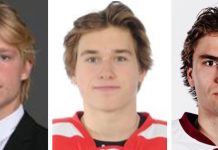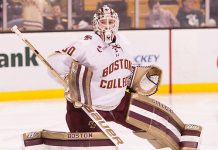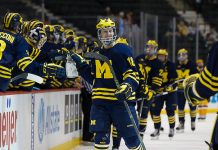I am, of course, well aware that I haven’t had much to say lately about the Hobey Baker race. I find that there isn’t much to say in October and November. Now, however, it’s December, and your humble Hobey pundit has deemed it time to jump back in, so I’ll share a few thoughts while I flip back and forth between the Big Chill at the Big House on the Big Ten Network and BU and RPI on the NHL Network.
Among the players distinguishing themselves most in the race for the Hobey, there aren’t too many surprises: Carter Camper has taken his scoring to another level with Miami, and averaging nearly two points per game, he has to be considered one of the front-runners for the Hobey, especially with the RedHawks riding high in the CCHA standings. BC’s Cam Atkinson is the national leader in goals with 16, and will also likely be in the mix for the award as the season goes along. I do have some reservations about how Atkinson will be received by Hobey voters, given the fact that Pat Eaves, Tony Voce, Brian Gionta, Nathan Gerbe, Chris Collins, etc. have not won the award, but we’ll get into that more later.
For now, the subject commanding my attention is ECAC Hockey, and more specifically, the Ivy League.
With Yale currently standing atop the national polls, there has been a certain amount of hand-wringing as concerns ECAC Hockey and the Bulldogs’ opponents. It had a familiar sound, as I’ve been hearing similar things about the conference for years whenever Cornell is enjoying a high spot in the polls.
Of course, commenting on polls and who’s overrated or underrated is generally not my department, and it is worth asking how Yale would perform against a WCHA or Hockey East schedule. That said, however, Yale also features four of the top ten scorers in the country – that’d be Broc Little, Andrew Miller, Denny Kearney and Brian O’Neill – and it’s highly likely that at least one member of that quartet will be a finalist for the Hobey when all is said and done. When that happens, I can’t help but wonder if we’ll hear the players’ accomplishments downplayed because of their conference the way their team’s performance has so far.
It is worth noting that ECAC Hockey hasn’t produced a Hobey winner since Lane MacDonald in 1989, and the conference’s last two contributions to the Hobey Hat Trick were a pair of Cornell goaltenders, David LeNeveu in 2003 and David McKee in 2005. To find a skater from the conference who made the top three, you’d have to go back to another Yale forward, Chris Higgins in 2002.
Personally, I don’t see any of these Bulldogs changing that this year.
Normally, I’m one of the first to stick up for players and teams in ECAC Hockey when their legitimacy is challenged, and I maintain that Yale has the talent to beat any team in the country, and will be in the mix for a spot in the Frozen Four this spring. However, there are too many things working against the Bulldogs’ high-scoring forwards to make a serious run at the Hobey.
For starters, there’s the Bulldogs’ schedule. I’m not going to run down ECAC Hockey, but adding two non-conference games against conference opponents (the Ivy Shootout) isn’t going to impress anyone. I do understand the merits of opening the season against opponents who are also playing their first games, but at the same time, it’d be helpful to the conference’s profile to see a high-end team like Yale play against top teams from other conferences as much as is feasible. Unfortunately, that hasn’t happened. With the two Ivy shootout games, three games with Atlantic Hockey opponents Air Force, Holy Cross and Sacred Heart, and a date with struggling Vermont, Yale’s stiffest non-conference test was a Colorado College team that didn’t even bother to play its No. 1 goaltender (although only Minnesota has scored more against the Tigers this year than Yale did). That is going to be an issue when the committee gets to talking.
Then, there’s the issue that I’ve touched on before: Yale’s balance. If there were a Yale player with the numbers of, say, Peter Sejna in his Hobey Year, the schedule issues wouldn’t stop that player from making it to the Hobey Hat Trick. As it is, though, Yale has four big-time scorers, which makes it hard to single any one of them out as a Hobey candidate. Miami, as we’ve discussed had that “problem” last year – of course, most coaches would love to have that kind of “problem” – and the result was Cody Reichard being the team’s Hobey finalist. I don’t think that’d happen with Yale, since the level of the scoring is higher, but I think the same issue comes back into play when the time comes to narrow the Hobey finalists to the Hobey Hat trick.
Anyone who thinks that Yale isn’t going to be a force to be reckoned with in March is kidding himself (especially if they get consistent goaltending), but I don’t see Yale making a real impact in the Hobey race. At least one of the four big scorers will get a finalist nod (at this point, I’m thinking Little), but unless someone’s numbers surge as the season goes along, I think that’s as far as it gets.
Of course, any Bulldogs who do get to that point probably won’t be the only ECAC Hockey representatives. 2010 Hobey finalist Chase Polacek of RPI is still among the nation’s top 20 scorers – and as I write this, is having a very nice game against Boston University – and as a Hobey finalist who returned for his senior year, will likely be commended for his commitment. However, there is also a pair of players from other Ivy League schools who could give Little some company.
For starters, there’s Jack Maclellan of Brown, who is currently second in the nation in points per game, with 20 points (9g, 11a) in 11 games. That includes three assists in the tie with New Hampshire and a goal in the tie with Boston University, with only Cornell having been able to keep Maclellan off the score sheet. Maclellan is definitely a surprise, currently scoring nearly twice as much per game as he did as a sophomore, but with Brown still rebuilding under Brendan Whittet, there’s probably a limit to how much consideration he’ll get. Still, Maclellan will face two more major conference foes, with games against BU and either Notre Dame or Minnesota State at the Shillelagh Tournament to start 2011.
At the other end of the ice, there’s Dartmouth goaltender James Mello, who is second in the nation in goals-against average and tops in save percentage. It’ll be interesting to see if he can keep it up, since he didn’t play in Dartmouth’s 7-3 loss to Yale (that was Jody O’Neill in net for the Big Green that night), or the 4-1 loss to Rensselaer. If Dartmouth and Mello are still looking good in late January (after they’ve played Yale, UNH and RPI), Dartmouth could be on its way to having only its second Hobey finalist ever (David Jones was first in 2007). Those games (along with a possible date with Boston College at the Ledyard National Bank Tournament) will be a prime indicator as to whether Mello is a contender or a pretender.
Back again soon with more Hobey analysis.


